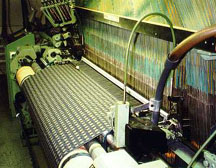Part 4
Go back to Part 3
The day following the McDonough meeting, Lyons contacted Rohner Textil to
see if Albin Kälin would be willing to participate in this project. He was
encouraged by Lyon's report and looked forward to meeting McDonough, who traveled
to Rohner a fortnight later. McDonough was encouraged
by the Climatex project. Nevertheless the Climatex fabric was
far from compostable, because the OEKO-Tex standards did not exclude all harmful
chemicals that would be released during composting.
In addition, McDonough was concerned about the use
of polyester, since it came from a fossil fuel. He explained to Kälin his design protocols,
which, according to Lyons, was like asking Kälin to "reinvent his mill." Kälin responded
enthusiastically to McDonough's ideas and eagerly awaited Braungart, who would
help begin the assessment of the manufacturing processes.
Braungart traveled to the mill in December of 1993.
He examined it very closely to determine what needed to be changed in order for them
to meet the design protocol. Braungart was "pleasantly surprised" by
Climatex
and its OEKO-Tex approval. He was also impressed with the mill, which, he
thought,
had dealt with ecology issues in a manner far ahead of
everything he had seen up to that point. Braungart's early suggestions were, as expected,
in agreement with McDonough's: produce the Climatex
product without using polyester so that all natural fabrics would be used, in
which would make the fabric compostable. The problem with Climatex, from McDonough's perspective,
was that it mixed organic and technical nutrients,
so the fabric could not be composted, yet technical nutrients could not be recovered.
 Braungart's evaluation required him to examine all stages of the fabric-construction
process. Because the mill was involved with the fabric weaving, he also inspected
the mill's suppliers: farmers, yarn spinners, dyers and twisters. Yarn spinners created a cord of
yarn/thread from the pieces of individual material fibers, such as wool. Yarn
twisters take two or more cords of thread/yarn and twist them together,
producing a much thicker and stronger piece of yarn. Dyers added the colors
to the yarn. Finishers added chemicals to the finished weave to make it
more durable, flame resistant, static resistant, and stain resistant, if
such qualities were required.
Braungart's evaluation required him to examine all stages of the fabric-construction
process. Because the mill was involved with the fabric weaving, he also inspected
the mill's suppliers: farmers, yarn spinners, dyers and twisters. Yarn spinners created a cord of
yarn/thread from the pieces of individual material fibers, such as wool. Yarn
twisters take two or more cords of thread/yarn and twist them together,
producing a much thicker and stronger piece of yarn. Dyers added the colors
to the yarn. Finishers added chemicals to the finished weave to make it
more durable, flame resistant, static resistant, and stain resistant, if
such qualities were required.
Susan Lyons was the main project coordinator and was
responsible for creating the "construction," or generalized set of weaving
patterns and color palette based on McDonough's designs. "Everyone on
the project knew that getting the mill contractors to open their books for
Braungart's inspection would be difficult, and keeping track of the fabric's
production would involve complex management well beyond the normal levels of
supervision." Consequently, the team concluded the more they could do
themselves, the easier it would be to produce the
new fabrics. Acting on this philosophy, they intended to have the mill perform the
role as the dyer as well as weaver. Kälin agreed:
"We need as few members in the pool as possible."
Go on to Part 5
 Braungart's evaluation required him to examine all stages of the fabric-construction
process. Because the mill was involved with the fabric weaving, he also inspected
the mill's suppliers: farmers, yarn spinners, dyers and twisters. Yarn spinners created a cord of
yarn/thread from the pieces of individual material fibers, such as wool. Yarn
twisters take two or more cords of thread/yarn and twist them together,
producing a much thicker and stronger piece of yarn. Dyers added the colors
to the yarn. Finishers added chemicals to the finished weave to make it
more durable, flame resistant, static resistant, and stain resistant, if
such qualities were required.
Braungart's evaluation required him to examine all stages of the fabric-construction
process. Because the mill was involved with the fabric weaving, he also inspected
the mill's suppliers: farmers, yarn spinners, dyers and twisters. Yarn spinners created a cord of
yarn/thread from the pieces of individual material fibers, such as wool. Yarn
twisters take two or more cords of thread/yarn and twist them together,
producing a much thicker and stronger piece of yarn. Dyers added the colors
to the yarn. Finishers added chemicals to the finished weave to make it
more durable, flame resistant, static resistant, and stain resistant, if
such qualities were required.